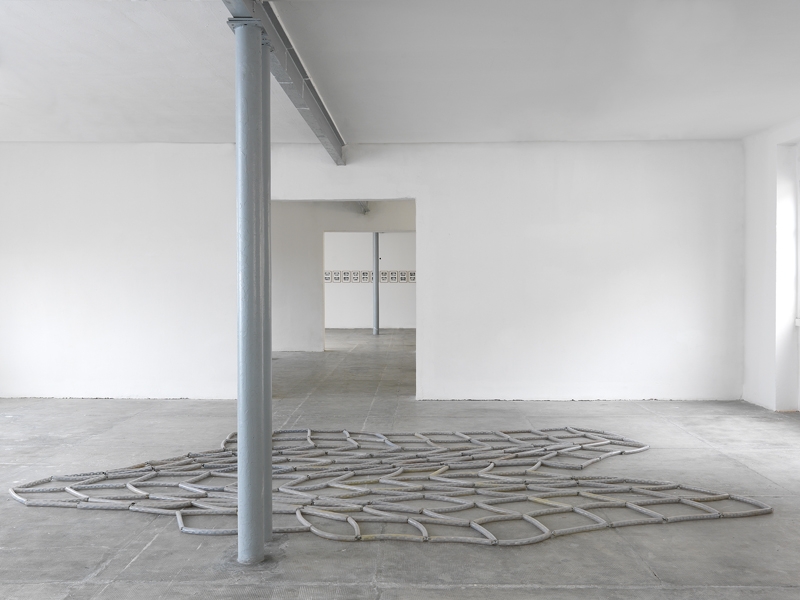My dad liked ikebana, the Japanese art of flower arrangement. Not that he ever attended any proper classes: the 1970s leanings for DIY suggested illustrated books and free experimentation instead. So I only grew accustomed to the basics of every composition: sky, earth and mankind (ten-chi-jin), like in a miniature landscape. Otherwise translatable as: vertical, horizontal and what exists between them, in accordance to constant ratios in lengths of the stems and variations in grace, colour and shape. Visiting Paolo Icaro’s exhibition made me feel like a Lilliputian taking a walk in a diagram of an oversize, conceptual ikebana.
The layout of the 13 works (stretching from the present day back to 1967, when Icaro was based in SoHo, New York, before returning to Italy and joining the front ranks of Arte Povera) is as careful as it is surprisingly playful and lighthearted, like a game repeated for the nth time. Vertical elements define the whole space: Linee equilibrio terra–cielo (Equilibrium Lines Earth–Sky, 2014), a site-specific series of thin aluminium rods balancing themselves from floor to ceiling, is scattered across two rooms. The ground is occupied by a large floor piece – Cumulo rete (Aggregation Net, 1968), a fluid ‘web’ of steel chains clad in tubular polyethylene, linked together with square links – and two wooden boxes, both from 1969. One, Blue Amalfi, contains 100 postcards from Amalfi, with sunny views of its sapphire sea and cerulean sky, so that it looks like a minuscule pond; the other, Scatola del profumo (Perfume Box), encloses a loaf of fresh bread, so that its smell – or, further away, our memory of it – subtly permeates the space. Another imaginary horizontal line is drawn across the gallery by Asse, boccole (Axis, Bushings, 1969): a couple of brass bushings inserted in two opposite walls at the same height.
The other works, installed in the intermediate space, at varying eye levels, are closely linked to the artist’s body and the passage of time: Ideal Biography (1976) is an invisible selfportrait, made of a dozen virgin photographic papers inscribed at the bottom by Icaro with a (possibly accurate) scribbled caption, such as ‘Le mani di nonno Luigi’ (Grandpa Luigi’s hands) or ‘In viaggio a Tokio, 1981’ (During a trip to Tokyo, 1981), as if in a private diary; Esercizi della mano destra sulla mano sinistra (Exercises of the Right Hand on the Left Hand, 1974–5) are eight sheets of 24 x 33 cm white paper, gently folded by placing one hand on top of the other one. In a corner of the third and last room, the tour closes with Stella Sirio (Sirius Star, 1969), a fourmetre- long stainless steel tube with a diameter of 2.5cm, diagonally implanted in the wall, offering the vision of a minuscule portion of the external sky.
The elegance of the overall configuration is so thoroughgoing that Icaro seems to make light of it by presenting, right at the entrance, his early series Foto, nicchie (Photos, Niches, 1974), a grid of 32 black-and-white prints recording all the different positions of a set of small objects arranged inside a recess in the artist’s studio in Woodbridge, Connecticut, like the ever-shifting bottles of a painting by Morandi. Right beside it stands Stele, luogo del ramo, orizzontale (Stele, Site of the Branch, Horizontal, 1985), where a real branch is ‘grafted’ atop a tall structure in white plaster, Icaro’s signature material. It, too, points outside, with all the natural beauty of its twisted asymmetry. Concerning these themes – nature, structure, divergence from these and mankind’s attempts at rationality – I think Wisława Szymborska says it all and better than anyone, as usual: ‘Yeti, down there we’ve got Wednesday, / bread and alphabets. / Two times two is four. / Roses are red there, / and violets are blue.’
This article was first publish din the March 2015 issue.
